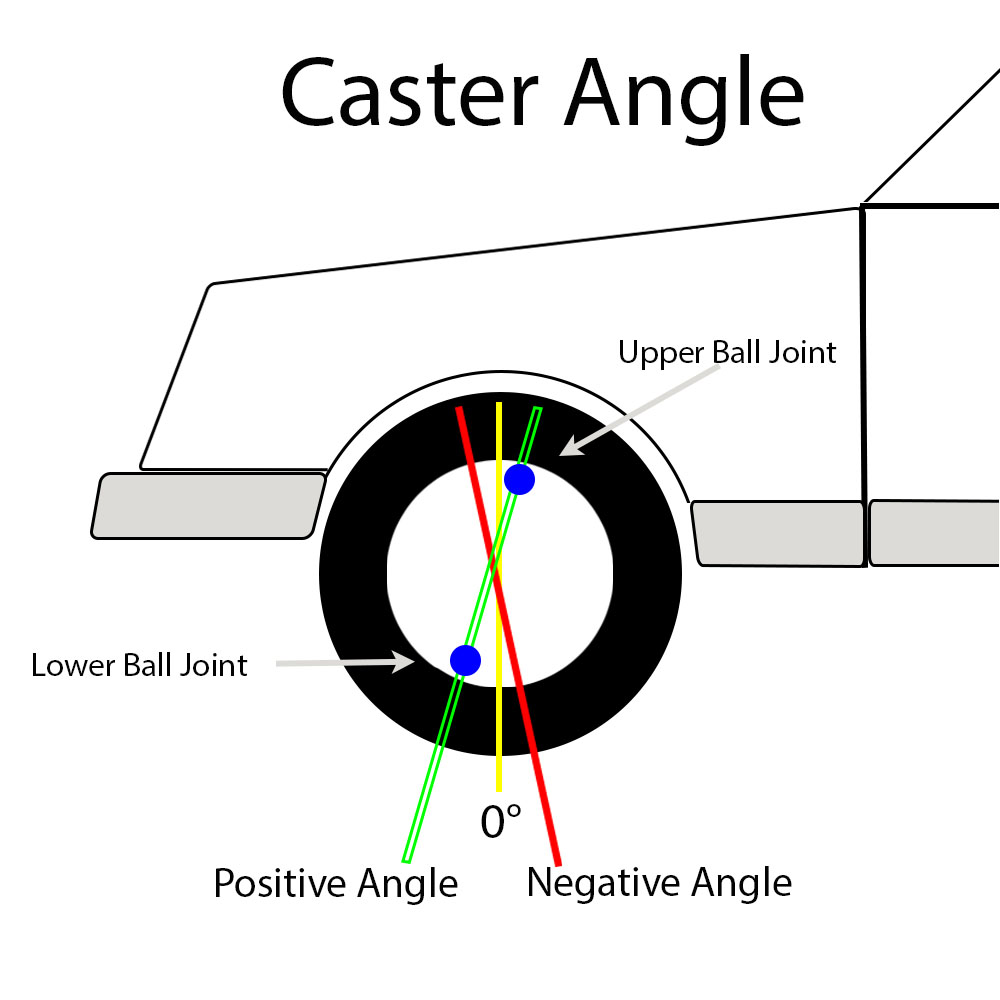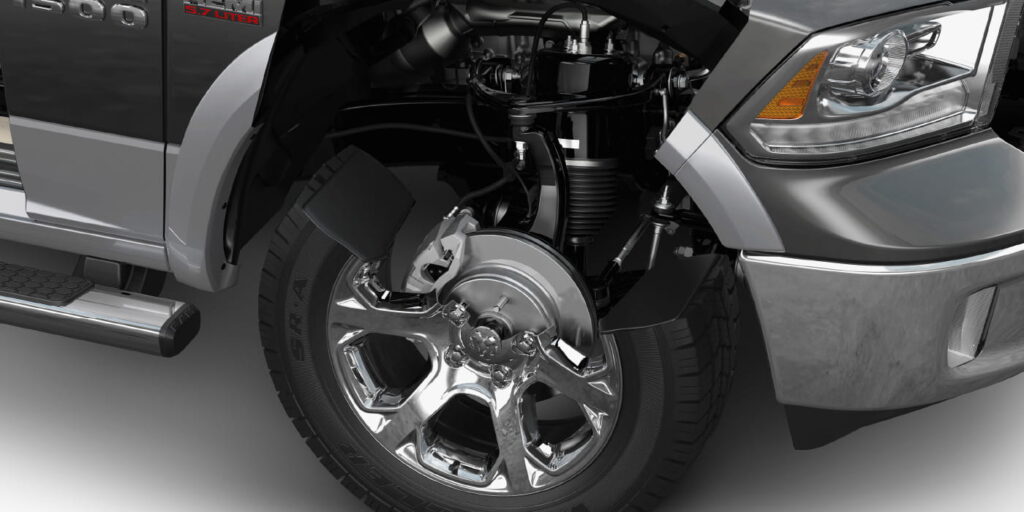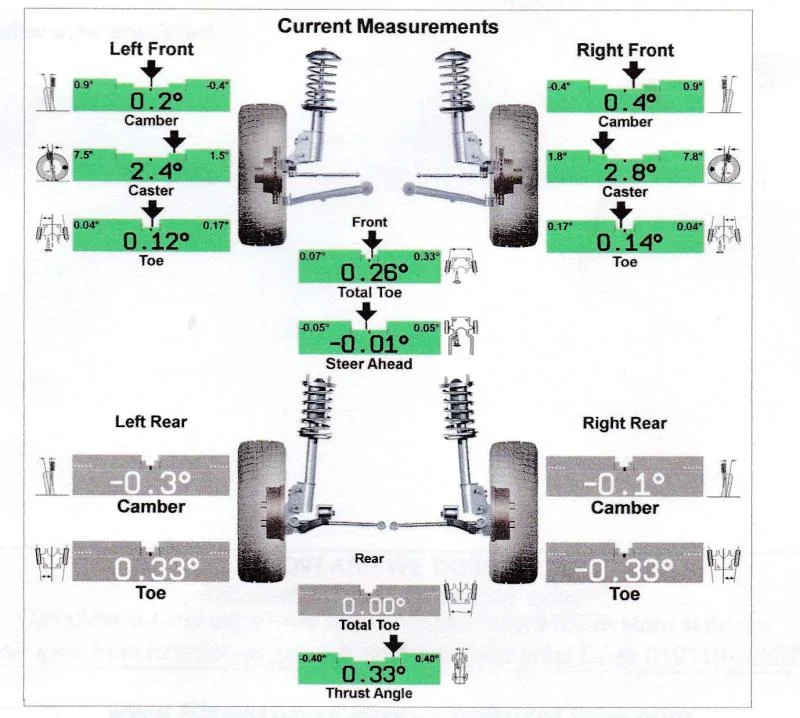The Dodge Ram 1500 is one of the most popular trucks on the road, known for its balance of strength, comfort, and towing capability.
The front suspension should be set with camber within ±2.25°, caster between 3.2°–4.8° (ideal around 4–4.5°), and toe kept near zero. Proper adjustment ensures straight tracking, even tire wear, and stable handling.
This guide will walk you through everything you need about Dodge Ram 1500 alignment specs and caster camber, including factory specifications, adjustment methods, lifted truck considerations, and troubleshooting common issues.
Understanding Alignment Basics
1. What Is Camber?
Camber refers to the inward or outward tilt of the wheel when viewed from the front of the truck.
- Negative camber means the top of the tire leans inward.
- Positive camber means the top of the tire leans outward.
The right amount of camber ensures the tire makes proper contact with the road. Too much negative camber quickly wears the inside of tires, while too much positive camber wears the outside edges.
2. What Is Caster?

Caster measures the angle of the steering axis when viewed from the side of the vehicle. A forward tilt is negative caster, while a backward tilt is positive caster.
Positive casters for trucks like the Ram 1500 are important because they provide straight-line stability, help the steering wheel return to the center after turns, and make highway driving more comfortable.
3. Why Toe Matters Too
While this article focuses on caster and camber, toe—the inward or outward direction of the tires when viewed from above—is also vital. Incorrect toe settings cause feathered tire wear and unstable handling. Toe works harmoniously with caster and camber to deliver a stable and predictable ride.
OEM Alignment Specs for Dodge Ram 1500
The following table provides sample factory alignment specs for a 2014 Dodge Ram 1500. Values may vary depending on year, suspension type, and wheel size, so always double-check for your model year.
| Configuration | Left Caster (°) | Right Caster (°) | Left Camber (°) | Right Camber (°) | Front Toe (°) |
| Air Suspension, 17″ Tire | 3.6–4.1 | 3.85–4.35 | –1.4 to –0.6 | –1.6 to –0.8 | 0–0.2 |
| Air Suspension, 20″ Tire | 3.6–4.1 | 4.0–4.5 | –1.4 to –0.6 | –1.6 to –0.8 | 0–0.2 |
| Non-Air Suspension, 20–22″ Tire | 3.0–3.5 | 3.4–3.9 | –0.3 to 0.5 | –0.3 to 0.5 | 0–0.2 |
These settings are designed to balance stability, steering response, and tire life. Keeping your Ram 1500 within these ranges will help maintain smooth handling and even tire wear.
Must Read: RAM 2500 EGT Sensor Normal Range Value – You Should Know!
Why Caster and Camber Specs Matter
A correctly cast caster ensures your truck tracks straight, resists wandering, and feels stable at higher speeds. Too little caster will make the steering twitchy, while too much will cause heavy steering.
Camber, on the other hand, influences tire contact with the road. If camber is out of spec, you’ll see uneven wear—especially if you tow heavy loads or drive on rough roads. Caster and camber significantly affect safety, performance, and fuel efficiency.
Adjusting Alignment on a Ram 1500

Unlike passenger cars, adjusting alignment on a Ram 1500 requires some specific steps.
- Inspect Components First – Check for worn ball joints, tie rod ends, and track bar bushings. No amount of alignment will fix worn parts.
- Set Toe First – Technicians usually set toe to around 0 to 0.05°. This gives the caster setting accurate reference points.
- Adjust Caster – On 2003–2012 trucks, rotating the eccentric washers at the control arm pivots adjusts the caster. On 2013+ models with radius arms, turning the lobe toward the rear increases caster.
- Balance Cross Caster – Keep left and correct caster values close. Too much difference can cause the truck to pull to one side.
- Test Drive & Recheck – After adjustments, a road test ensures the truck tracks straight and feels stable.
Lifted and Modified Ram 1500 Trucks
Lift kits change suspension geometry, which directly affects caster. A truck lifted over 2–3 inches may lose caster, causing wandering or instability.
- Up to 3.5 inches of lift – Stock control arms usually provide enough adjustment.
- Beyond 3.5 inches – Long-arm kits or caster-correcting brackets are recommended.
- User Experiences – Ram owners often report best results with caster between 3.5–5°, depending on lift height. This strikes a balance between highway stability and steering comfort.
If your Ram has aftermarket wheels and tires, remember that offset and size can also influence handling, making correct alignment even more critical.
Read More: Will Dodge 5 Lug Fit Chevy 5 Lug – Complete Review!
Common Symptoms of Incorrect Alignment
- Too Much Caster – Heavy steering, slow turning response, and sometimes driveline vibration.
- Too Little Caster – Truck wanders on the highway, steering feels light or twitchy.
- Uneven Caster – Pulls to one side or leans.
- Incorrect Camber – Inside or outside tire edge wears much faster.
If you notice these issues, an alignment check should be your first step before replacing tires or suspension parts.
2004 Dodge Ram 1500 Alignment Specs Caster Camber
For the 2004 model, camber should sit close to zero, usually within half a degree on each side, while caster is best around 3.5–4.5°. Keeping the toe near zero ensures safe handling, even tire wear, and smooth highway tracking.
2016 Dodge Ram 1500 Alignment Specs Caster Camber
On the 2016 truck, camber usually ranges from –0.5° to +0.5°, while caster falls between 3.5° and 4.5°. The toe should be near zero to avoid pulling, improve control, and extend your tire’s lifespan.
2005 Dodge Ram 1500 Alignment Specs Caster Camber

A 2005 Ram 1500 performs best with caster around 3.2°–4.8° and camber near zero for balanced tire contact. Toe adjustment should stay minimal. Correct alignment keeps your steering centered, prevents uneven wear, and makes the truck safer and smoother.
2007 Dodge Ram 1500 Alignment Specs Caster Camber
For the 2007 version, caster typically measures 3.5°–4.5°, while camber is set close to zero. Toe alignment should remain minimal. Sticking to these specs helps your truck track straight, reduces tire wear, and gives you more confidence behind the wheel.
2012 Dodge Ram 1500 Alignment Specs Caster Camber
In 2012 models, caster settings were around 3.5°–4.5°, and camber was near zero, which kept steering stable and predictable. The toes should remain almost flat. These adjustments help avoid wandering on the road, extend tire life, and maintain safe control, especially at highway speeds.
2006 Dodge Ram 1500 Alignment Specs Caster Camber
The 2006 truck benefits from camber within ±0.5° and caster between 3.2°–4.8°, ideally around 4°. Toe alignment should be minimal. Keeping these specs ensures stable steering, smooth highway driving, and even tread wear so you avoid costly tire problems.
2017 Ram 1500 Alignment Specs
In the 2017 model, caster angles usually range from 3.5° to 4.5°, camber falls near zero, and toes should be kept almost flat. Correct alignment delivers straighter tracking, less vibration, longer tire life, and a safer, more comfortable driving experience.
Dodge Ram Alignment Specs
Across Ram trucks, caster usually falls between 3° and 5°, camber close to zero, and toe near zero. These numbers give the right balance of steering stability, tire wear prevention, and safe handling. Always confirm exact settings for your model year.
FAQs
1. What Are The Specs For Camber Alignment?
Camber specs usually range from –0.5° to +0.5° on most trucks. Staying within this window helps avoid uneven tire wear and steering issues.
2. How Much Is A Front End Alignment On A Dodge Ram 1500?
A professional front-end alignment usually costs between $100 and $160. Prices vary depending on the shop, location, and whether additional suspension adjustments are required.
3. How To Align The Steering Wheel On A Ram 1500?
Adjust both tie rods evenly to center the steering wheel after setting the toe. This ensures the wheel stays straight while your truck drives true.
4. How To Adjust Camber On a 2015 Ram 1500?
Camber is adjusted using the lower control arm bolts. Small changes move the wheel in or out, correcting tilt to achieve proper camber alignment.
5. How Much Camber Is Acceptable?
Most vehicles allow around half a degree of positive or negative camber. Anything beyond this often causes uneven tire wear and poor handling.
6. What Is A Normal Camber?
Normal camber sits close to zero, keeping the tire flat on the road. Slight negative camber may be used for better cornering stability.
7. What Is The Perfect Camber?
The “perfect” camber depends on use. For daily driving, nearly zero is ideal. Performance setups may use slight negative camber for sharper cornering grip.
8. What Is The Standard Camber Angle?
The standard camber angle is usually between –0.5° and +0.5°. This range gives stable handling, even tire wear, and safe everyday driving.
9. What Do I Adjust For Camber?
Camber is adjusted by moving control arms, strut bolts, or cam bolts, depending on suspension type. Each changes the tire’s inward or outward tilt.
10. How Much Toe-In Is Acceptable?
Acceptable toe-in is very minimal, usually less than 0.15°. Too much toe quickly scrubs tires, while near-zero settings give smoother, straighter tracking.
Conclusion
Getting the alignment right on your Dodge Ram 1500 isn’t just about numbers—it’s about safety, comfort, and saving money on tires. With caster typically between 3.2°–4.8°, camber close to zero (±0.5°), and toe kept near zero, you can expect straighter tracking, longer tire life, and more confident steering. Whether driving a stock truck, towing heavy loads, or running a lifted setup, keeping caster and camber within factory specs ensures your Ram handles the way it was designed.
If you notice pulling, uneven tire wear, or twitchy steering, an alignment check should be your first step before replacing parts or tires. Investing in caster-correcting components for lifted or modified trucks can make a massive difference in highway stability.
In short, maintaining proper caster, camber, and toe is one of the simplest yet most effective ways to keep your Ram 1500 safe, stable, and performing at its best for years to come.




